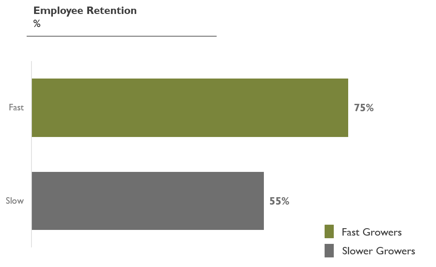Any effort to take the guesswork out of leadership for busy CEOs is worth the read, and the Edison Growth Index 2019 report again lays out critical insights on how fast growers build and scale effectively. This year’s research gives all of us who are pursuing growth (and isn’t that all of us?) facts for shaping a way forward.
A big part of what fast growers accomplish, the report shows, is not just hiring faster, but hiring better employees than their slower-growing peers.

I found it especially telling that fast-growing companies don’t just increase revenue per employee at a rate three times that of slower growers— while growing headcount — they're also significantly better at retaining employees. The chart to the right shows that fast growers hold onto 36% more employees than slower-growers.
That kind of retention doesn’t just happen. It’s the mark of a company that pays close attention to employee engagement. Lo and behold, the report notes four characteristics that fast growers have in common when it comes to culture. At the top of the list? “Defined methods for engagement and cadence of communication.”
What’s more, the other three characteristics have a proven impact on employee engagement: Fast growers operate with financial transparency, clear objectives, and a defined process for performance management that includes quickly addressing sub-par performance.
When employees are engaged, through these and other strategies, they’re more productive. Engaged employees can make a company as much as 22% more profitable, and companies who have sustainable levels of high engagement see operating margins up to three times higher than those with low engagement. Flip that around, and you see that disengaged workers cost American businesses as much as $550 billion per year in lost productivity.
These numbers (and the ideas behind them) are all well and good for the fast growers who are leading the pack, but what is a slower grower — or a fast grower, who is not reaching its full potential — to do with all this?
I have some ideas.
First, all this recruiting and hiring is incredibly expensive. With the talent crunch like it is after years of record job growth, hiring is a challenge for even highly desired companies. What you do after the hiring process goes a long way toward determining how much value you get from those hires you so carefully chose.
Fast growers have these traits in common when it comes to hiring and retention:
They measure employee engagement and utilize those metrics to build on their strengths.
We know that high engagement facilitates successful hiring and retention, and engaged cultures attract talent through employee referrals and by reputation. For example, if you’re known as a company that most values trust — know it, own it, and lean on it to attract others who will appreciate it. What’s working can keep working even as you build, if you really grasp those characteristics that keep your crew engaged.
However, while every organization has its own unique surface-level characteristics (or “employer brand”), it’s important to dive deeper and uncover which drivers of employee engagement truly matter for your workforce. Think about it this way: Every business has key metrics they track regularly, like cash or output, in order to understand how the business is performing and make decisions. So why wouldn’t you have a metric around people, your most valuable asset? Without access to reliable and statistically-valid engagement data, you have no real way to measure engagement success against other business goals.
They take a focused, well-defined approach to their own growth and that of employees.
A recent Glassdoor study found that 79% of working adults would consider a company’s mission before applying for a job. (This is especially important to millennials, who our research finds are driven most by purpose and shared values.) Employees are much more likely to be engaged when they know that their contribution is meaningful and they have the opportunity to develop and contribute to a defined mission. Mobilizing employees throughout the entire organization around company objectives and KPIs is a critical element of driving results and showing them how their work makes an impact.
Clear, continuous performance management ensures that employees understand their growth opportunities and see that company leadership is acting on feedback, furthering trust between employees and leaders. It’s also essential that sub-par performance is swiftly addressed via clear, timely feedback and support to succeed. Otherwise, the process becomes rote and meaningless (and productivity takes the hit).
They are guided by leaders who develop people and execute on strategic vision as essential to continuous employee engagement.
Top candidates are more concerned than ever about culture, which depends on involved leadership. Engaging and retaining employees requires ownership from all levels of the executive team, not only HR. Quick fixes waste everyone’s time; successful leaders instead look to the data to understand the state of engagement on their teams and how to translate that data into actions that motivate and drive results. Making strategic investments in building a thriving culture and solving for the most critical engagement blockers helps companies become skilled talent magnets and workplaces of choice.
Of course, it was the hiring and retention numbers that I lasered in on, but the report provides much broader points about fast growers. Winning performance breeds higher engagement and higher engagement contributes to more winning — it’s a virtuous cycle.
Check out the full report here... it’s a recommended read for every growth company leader.


